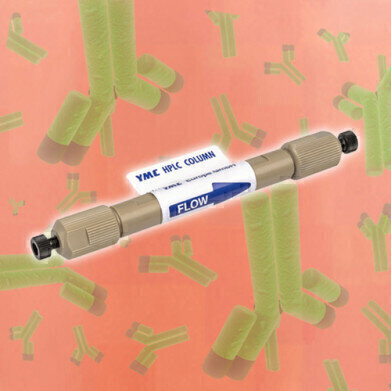HPLC, UHPLC
Native online SCX-MS analysis of monoclonal antibodies using YMC’s BioPro IEX SF
Aug 25 2020
Cation exchange chromatography (CEX) is a non-denaturing technique used for separation and isolation of protein charge variants before characterisation via MS. This is usually a two step process, where the specific charge variant peak of interest has to be isolated prior to characterisation via mass spectrometry because in CEX mostly non-volatile buffers are used, which are not compatible with MS.
The coupling of MS to CEX would save time and exclude possible artefacts of the long isolation process. In addition, it is possible to overlook minor species of e.g. monoclonal antibodies (MAb) that do not exhibit distinctive UV peaks in this two-step approach.
Direct coupling of SCX to ultrasensitive MS
In this application note based on a study by Yan et al., high resolution SCX (strong cation exchange chromatography) was coupled directly to an ultrasensitive online native MS [1]. A combined pH and salt gradient based on a MS compatible buffer system was utilised. YMC’s BioPro IEX SF, a non-porous strong cation exchange column, was used for the characterisation of the NIST mAb.
Optimised mobile phase and gradient
The mobile phase composition and gradient were optimised to achieve an efficient separation of charge variants by changing the pH and the salt concentrations in a range where MAbs are maintained in their native states.
A post column splitter was used, so that nanospray ionisation could be performed at the same time as the separation was being performed on an analytical scale with an ideal flow rate of 0.4 mL/min.
Separation of MAb charge variants
The separation of the NIST mAb with an isoelectric point (pI) of 9.2 and its variants is shown here. In addition, five further in-house MAbs with pIs between 6.3 and 9.2 were analysed (not shown). The retention times in general correlate with the pI of the MAbs. Several antibodies with a pI of 8 or greater eluted at a pH below 7.4, but each MAb exhibited a different retention time. All MAbs showed a good chromatographic separation of charge variants. With this SCX-MS method using YMC’S BioPro IEX SF it is possible to detect and measure minor charge variant species present at levels below 1% in all six MAbs.
[1] Anal. Chem., 2018, 90, 13013-20.
Digital Edition
Chromatography Today - Buyers' Guide 2022
October 2023
In This Edition Modern & Practical Applications - Accelerating ADC Development with Mass Spectrometry - Implementing High-Resolution Ion Mobility into Peptide Mapping Workflows Chromatogr...
View all digital editions
Events
Apr 23 2024 Kintex, South Korea
Apr 23 2024 Seoul, South Korea
Apr 28 2024 Montreal, Quebec, Canada
May 05 2024 Seville, Spain
May 15 2024 Birmingham, UK














